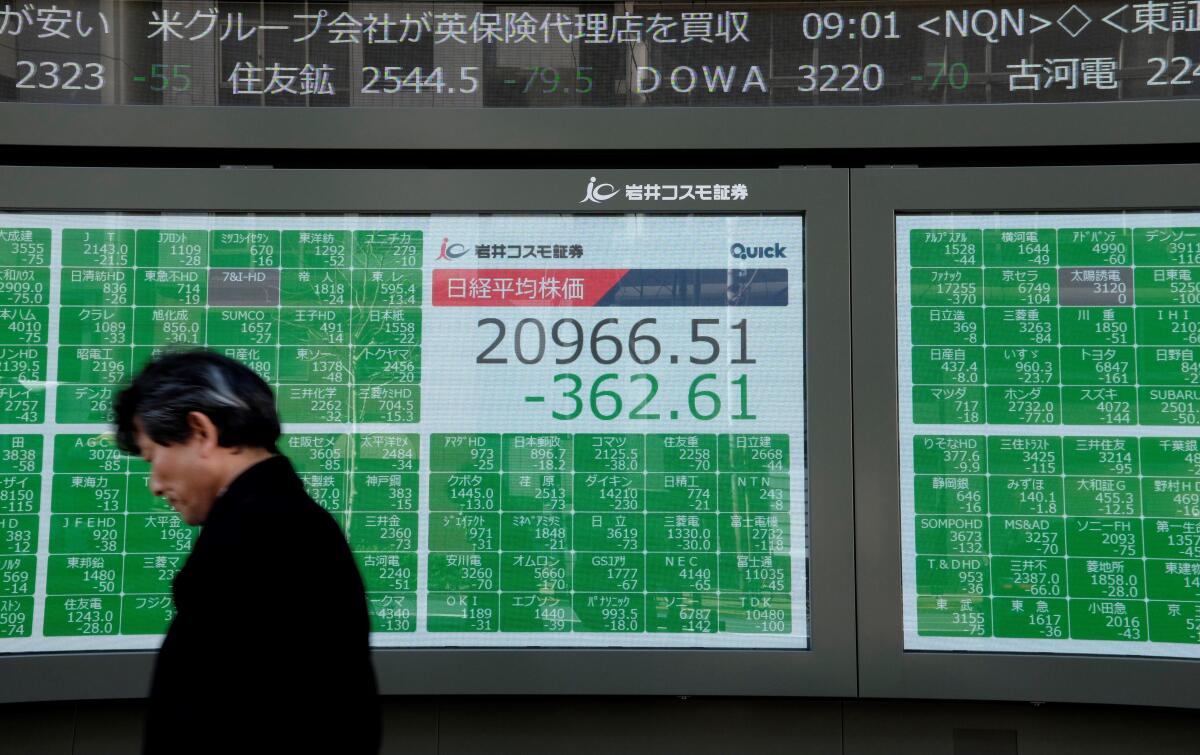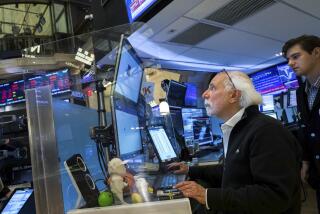Stock futures, Asia markets crash as oil war and coronavirus combine for mayhem

- Share via
American stock futures tumbled, with losses triggering exchange rules that limit declines at 5%, as plummeting oil prices added to the backdrop of dread surrounding the novel coronavirus.
Japanese stocks sank 6%. For the first time ever, the 10-year U.S. Treasury yield fell below 0.5% and the 30-year yield dropped under 1%.
The spark was a full-blown oil price war that followed Russia’s decision to walk away from talks with the Organization of the Petroleum Exporting Countries on production limits. Saudi Arabia then said it plans to boost oil output next month to more than 10 million barrels a day.
Oil prices plunged late Sunday, at one point by 31%, the most since the Gulf War in 1991. Some strategists now see oil prices falling below $30 a barrel, as a deluge of supply combines with a shock to demand from the virus.
Oil futures sank by 31% in a matter of seconds after the open of trading Monday in Asia, the worst decline since the Gulf War in 1991.
Although energy and commodity stocks make up only about 5% of the S&P 500 index, if the oil price crash were sustained it would upend politics around the world, exacerbate strains in U.S. high-yield corporate credit and complicate the work of central bankers as they try to model the effects of the virus on economies. It would otherwise prove a boon to consumers, but the coronavirus is increasingly keeping them at home.
Volatility has been rampant in markets around the world amid an outbreak that has infected more than 110,000 people and killed more than 3,700. At least 10 billion shares have traded on U.S. exchanges each day for two weeks, gauges of equity turbulence are at nine-year highs and strategists have begun lowering earnings forecasts for the rest of the year.
The spreading coronavirus has kept investors on edge for weeks, forcing upon them the near-impossible task of assessing its eventual effects on the global economy. Now, with Saudi Arabia and Russia initiating a price war in the oil market, they’ll have to contend with crude prices that are in free fall.
Futures contracts on the S&P 500 sank as much as 5% on Sunday from a Chicago Mercantile Exchange reference price calculated during the final 30 minutes of trading Friday. Although futures can continue trading at or above that price, they were pinned at that level as of 10:11 p.m. in New York, raising the specter of an ugly opening there on Monday.
“It is too early to expect a market bottom,” Satya Pradhuman, director of research at Cirrus Research, wrote in a note to clients. “Credit spreads are likely to widen further from here. In addition, earnings risks abound and estimates are still likely to fade further.”
Contracts on indexes such as the S&P 500 and Nasdaq 100 are crucial elements of the global price discovery system, giving traders a price proxy and instruments to speculate on the world’s biggest stock market when regular exchanges are closed.
“These things are all designed to stop a market panic and cause a bit of a pause in trading,” said Shane Oliver, head of investment strategy and chief economist at AMP Capital Investors. “It can have the perverse effect of increasing the downward pressure on other markets, particularly until the U.S. market opens.”
The last time futures selling tripped the limit down rule was the night of Nov. 8, 2016, as investors adjusted to news that Donald Trump would win the presidency. The price held at 5% below the prior day’s close around midnight and stayed there for about half an hour before turning higher. The entire drop was erased minutes after the opening of regular trading.
But that might not be a model for this week.
“This time ‘round things might be different, and the market is behaving like a recession is due to happen,” said Margaret Yang, a strategist at CMC Markets Singapore.
More to Read
Inside the business of entertainment
The Wide Shot brings you news, analysis and insights on everything from streaming wars to production — and what it all means for the future.
You may occasionally receive promotional content from the Los Angeles Times.











